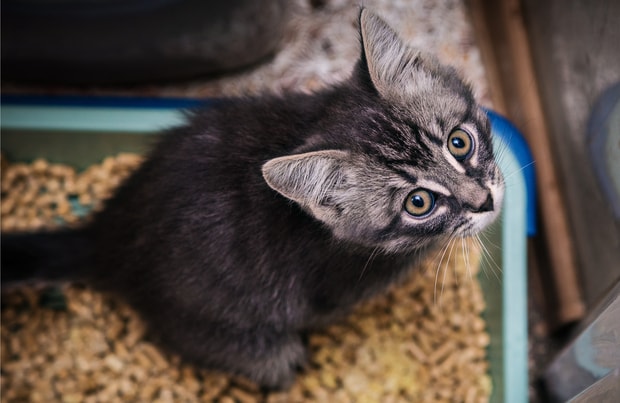A litter box is a necessary accessory to any home with a cat. Just because you have one (or many) feline-reliving stations positioned around your home, however, doesn’t mean that they have to be an eye sore.
We spoke to several cat experts and interior decorators to get the scoop (pun intended) on how to spruce up your cat’s litter box area so that it doesn’t clash with your home décor.
Give Your Cat His Own Space
As the owner of five cats, Los Angeles-based interior designer Peter Cass knows how to artfully display a litter box. One of his favorite suggestions is to give your cat his own area to comfortably relieve himself in.
“Some people cut kitty doors into utility doors [and] hide the litter box in its own little room,” he says. “If you have a spare closet in your house, this may be the way to go.”
Color Coordinate
Another tip from Cass is to pick a cat litter box that blends color wise with the location you are putting your litter box in to help conceal it. “That way it can be hidden in plain sight,” he says.
Keep it Clean
Marilyn Krieger, an author and certified cat behavior consultant, says that the best way to improve the smell of your cat’s litter box(es) is through regular maintenance.
“Litter boxes need to be scooped at least once a day,” she says. “Additionally, the litter needs to be dumped from the boxes on a regular basis.”
Krieger suggests washing litter boxes with hot water and mild, unscented dish soap before refilling them with new cat litter.
Another option, says Cass, is to have an automatic-release or plug-in air freshener somewhere close to the litter box. Just make sure that it’s kept out of your cat’s reach, as air freshener oils can stain wood and fabrics if knocked over and can be toxic to pets if ingested.
Try a Room Divider
“It doesn’t matter if you have modern or traditional décor, room dividers or partition screens are a nice quick fix to hide the litter box,” says interior designer Guillaume Gentet.
With a room divider, kitty litter is contained in one area so it doesn’t end up flying around everywhere.
Use a Mat to Trap Stray Litter
“The old school, faux-grass welcome mats are a thing of the past,” says Cass. “Now, there are many that come in all colors and designs. Select one that complements your decor and simply place where your cat typically jumps out of the box.”
Another solution is to use clumping-style litter in lieu of traditional litter, which tends to stay in the box as opposed to being flung around the surrounding areas. Gentet’s go-to solution is to put a cat’s litter box on a clean cooking sheet that looks like a grill.
“The litter drops down and you clean simply clean it out,” he says.
Don’t Skimp on The Number of Litter Boxes You Have
“A cat’s relationship with the litter box is complex, especially in a multi-cat household. When you have more than one cat, you need more than one litter box,” says applied animal behavior counselor Francine Miller.
The general rule is to have one more box than the number of cats you have (i.e. if you have two cats, you need at least three boxes). This is an especially important rule to follow to help avoid litter box aversion, Miller says.
Krieger adds that cats need choices and are less likely to feel stressed about relieving themselves if they have ample options available in various locations around the home.
Be Wary of Plants
Disguising a litter box with a plant may seem like a good idea, but do so with caution. There are a number of plants that are toxic to cats so any plants in the house should be thoroughly researched. In addition, a houseplant may easily become a toy for your feline.
“Cats are notorious for playing in the plants and attacking them, especially when they are young kittens, so avoid putting any plants with hanging parts in the area that the cats are bound to bat and try to attack,” says Cass.
Don’t Hide the Box Completely
According to Krieger, completely hiding a cat’s litter box may be detrimental.
“Instinctually, cats don’t want to do their business in a place where they may be ambushed or cornered. Some cats become stressed and may develop litter box issues when their boxes are covered,” she says.
Wherever you decide to put your boxes, make sure they’re in areas that are readily accessible for your cat, easy for them to find and easy for them to use, she adds.
Make Sure Your Cat is Comfortable
If you notice that your cat is stressed about relieving himself in his litter box, then it’s important to make some changes to your arrangement.
“Kitties who aren’t happy with the set up often avoid using them,” says Krieger. “One obvious sign that cats are unhappy with the set up includes eliminating outside the litter box. Some cats who don’t feel secure while eliminating will stand up while urinating and rush out of the box as quickly as possible after they’ve eliminated,” she adds.
And don’t assume that a cat boycotting his litter box means that he doesn’t like the setup.
“Medical problems can cause cats to not use their boxes. Additionally, stress can also cause medical problems,” says Krieger.
If this occurs, take your cat to the vet before making any changes to his litter box area.

Nicole Pajer is a freelance writer who lives in Los Angeles with her husband, energetic Doberman, and rat terrier.
Share:









